“Don’t mistake my kindness for weakness. I am kind to everyone, but when someone is unkind to me, weak is not what you are going to remember about me.” – Al Capone
One of America’s most notorious gangsters, Al Capone was known as much for his sense of style as he was for his psychopathic tendencies.
The Formidable Years
Arriving just weeks before the Great Blizzard of 1899, Alphonse Gabriel Capone was born on January 17th of one of the coldest years on record in New York City. His parents, both immigrants from Italy were hardworking people living in Brooklyn. His father, Gabriele Capone was employed as a barber and his mother, Teresina Raiola worked as a seamstress. One of the nine children, Alphonse – nicknamed Al – was the leader of the family once his ties to the mob took hold. Two of his brothers; Salvatore (known as Frank) and Ralph (Bottles) Capone worked under him in his criminal empire while his brother James, ironically, became a Prohibition agent in Nebraska.
As a young child, Capone was a promising student but had difficulties adjusting to the rules of the parochial Catholic school he attended. By the time he was 14 years old, Capone dropped out of school after being expelled for assaulting a female teacher by punching her in the face. After leaving school, Capone worked a number of odd jobs and joined a few local gangs including the Bowery Boys and the Junior Forty Thieves. Bored of the unsophisticated smash and grabs or robberies, he set his eyes on the powerful Five Points Gang in Manhattan. Given a job working in a local saloon, he became the protege of the bartender who happened to be a racketeer named Frankie Yale. It was during this stint that Capone was given the nickname “Scarface” after he mistakingly insulted a woman while bouncing the door. Despite it being, by all accounts, accidental, Capone was slashed across the face by her brother Frank Gallucio. From then on, he tried hiding his scar by requiring photographers to only shoot him from the right side and not the left, claiming the wound was an old war injury.
On December 30, 1918, Capone married his girlfriend who out of wedlock had given birth a month earlier to their first son, Albert Francis “Sonny” Capone. Since Capone was only 19 at the time, his parents had to consent to the marriage.
About a year later, Capone was made an offer by a new mentor; gang boss Johnny Torrio to accompany him to Chicago. Finding employment as a bouncer at the Harvard Inn brothel, which was anything but Ivy League, Capone and Torrio forged a close friendship and soon Capone was working as Torrio’s personal bodyguard. For extra money, Capone began promoting local fight nights and soon became a regular in the sports pages of the local newspapers. When the head of the gang Capone and Torrio worked for was killed, Torrio became the godfather of the largest organized crime group in all of Chicago. Capone was now Torrio’s most trusted friend and became his consigliere in addition to his personal bodyguard. Capitalizing on Chicago’s location as a railroad epicenter on Lake Michigan, they quickly began to strengthen the groups stronghold across the City.
Capone always saw himself as a businessman, who was providing for his family and in his own words “giving the people what they want” or “satisfy a public demand”.Violence was part of the business, which was not a sin to him, but simply a way to protect his business and his family. On the other hand, Torrio was more subtle and tried to negotiate agreements with rival gangs in an effort to avoid gang wars. Despite his willingness to work fairly with other gangs, Torrio’s allies the Genna Brothers began to encroach on the territory of a smaller gang called the North Side Gang led by Dean O’Banion.
O’Banion approached Torrio in an effort to negotiate a truce but found that Torrio wasn’t as helpful as his reputation claimed and Torrio arranged for the Genna Brothers to assassinate O’Banion at his flower shop. With O’Banion out of the picture, his close friends and fellow gangsters Hymie Weiss, Bugs Moran and Vincent Drucci stepped up and vowed revenge against Torrio and all those involved in their boss’ murder.
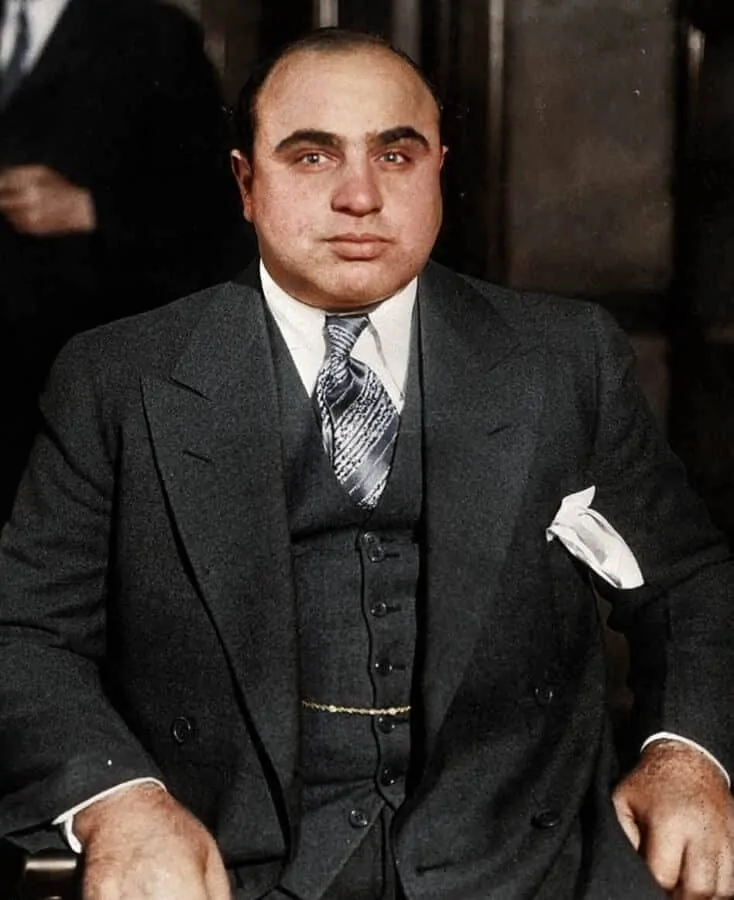
Capone Becoming the Boss at 26 Years of Age
In a tactical ploy, Capone was ambushed leaving him unhurt but unable to work as he needed time to rest. A little over one week later, in January of 1925, Torrio was shot several times by a hitman on his return home from a shopping plaza. Despite surviving the assassination attempt, Torrio was shaken and resigned as the leader leaving the reigns to Capone, who at just 26 years of age became the new boss of Chicago’s largest crime syndicate.
Capone who was already known publicly, realized he could capitalize on this and began to act as a modern day Robin Hood stealing from the rich and donating money to the poor. He opened a soup kitchen and shelter for the homeless and gave a significant amount of money to a number of local charities. To protect himself from the law, he befriended the Mayor of Chicago and the upper brass of the Chicago Police Department. He was a common fixture in the papers and was heralded as an almost savor to the city. When he attended public events such as a baseball game, crowds would give him standing ovations and players would approach him to shake his hand. Capone was a bonafide celebrity and he used his power and influence to take a stronghold of the city.
He countered with more violence in an effort to take control of all the illegal breweries and the transportation network that stemmed from Canada. He was known for being a nice guy; the type of guy who likes a Presidential candidate would kiss babies during the day, but at night, he would kill the parents in their sleep. This type of demeanor translated into the way he conducted business. He would casually chat up owners of local establishments with a smile and a handshake offering his bootlegged alcohol to them. However, if they refused, later that night henchmen would arrive and bomb the restaurant or bar. Over the course of a single decade, more than 100 people were killed in such bombings, yet although people knew it was Capone behind them, most only ever saw his smiling face and warm embrace.
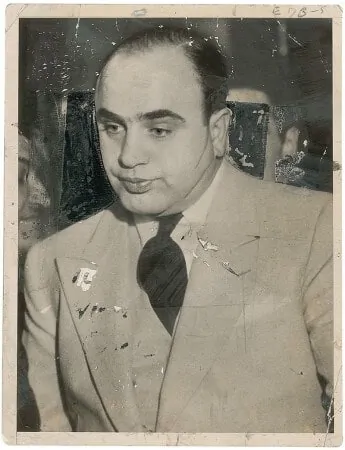
You Don’t Mess With Capone
While Capone carried out many of the hits himself as a younger man, he now rarely take matters into his own hands. However, when one of Capone’s accountant was picked on by Capone’s rival Jowe Howard, Capone was determined to send the message: “You don’t mess with Capone”.
So in broad daylight, Capone walked up to Howard in a busy bar, greets him and then fires his gun into his cheek six times while holding him on his stool at the bar. Once sure Howard is dead he just dropped him and walked out. The bar was full of people, everybody saw Capone did it and even the police knew it was him for a fact. Capone is asked a few questions by the officers and walks away as a free man without any arrest or conviction. Nobody is willing to testify against him because you don’t mess with Capone. It’s hard to believe that this degree of lawlessness existed but Capone had built an empire were he was the absolute monarch.
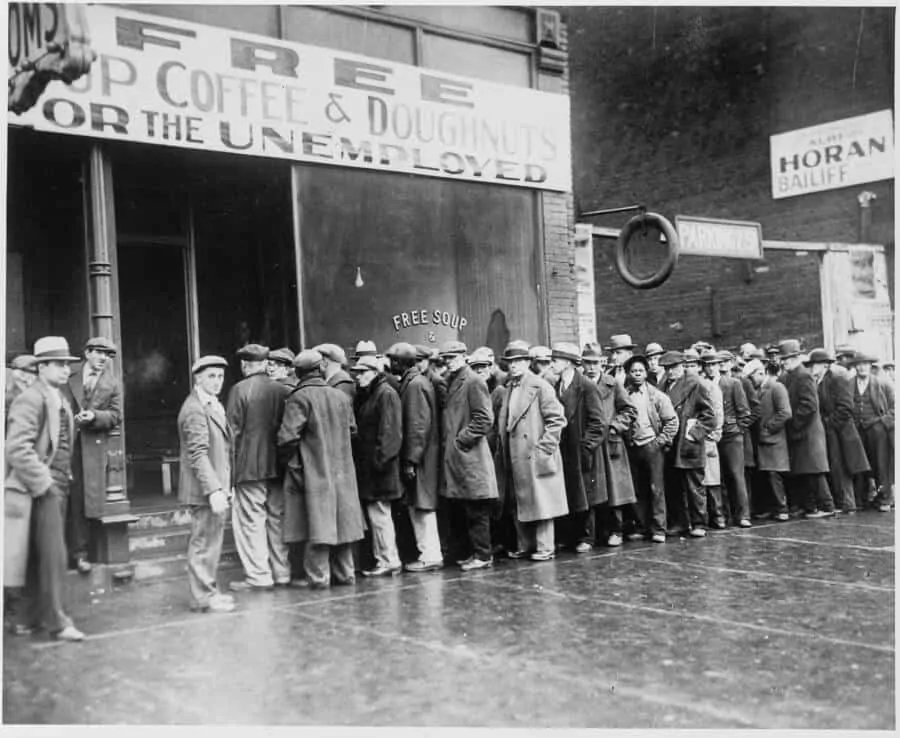
However, this kind of behavior also nurtured enemies. In a strategic ploy to assassinate Capone, the North Side Gang pulled a ruse to lure Capone to his window at his headquarters at the Hawthorne Inn in Cicero. When he appeared, gunmen in several cars lining the street opened fire with machine guns and shotguns. Somehow, despite the mass chaos, Capone survived without so much as an injury. The ever calculated yet violent Capone distracted Weiss, the initiator of this stunt, by offering a truce to only three weeks later kill Weiss at the same location O’Banion’s life was taken just a few years earlier.
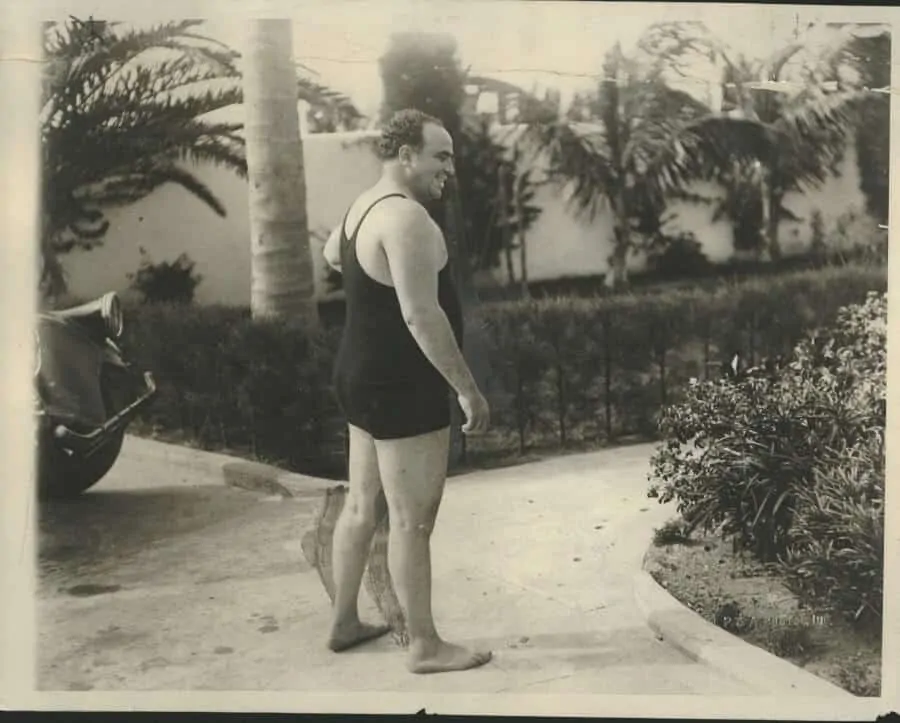
Spontaneous Getaways
Realizing that he was lucky to have gotten away, Capone now took more security precautions. As such, Capone and his entourage would randomly leave Chicago by showing up at a local train station without notice and taking over an entire Pullman sleeper car. The crew would head across country and spend a week in lavish hotels under false names. To save money, Capone bought a retreat for $40,000 in Palm Island, Florida to escape to when the stress of daily life as a mobster was too much to bear.
Capone became increasingly paranoid, and opted for cash over bank accounts that the feds could seize. He used Western Union to transfer money, but never anything over $1000. All his property was registered in false names and Capone, despite still being a fixture in the press, tried desperately to remain out of the spotlight.
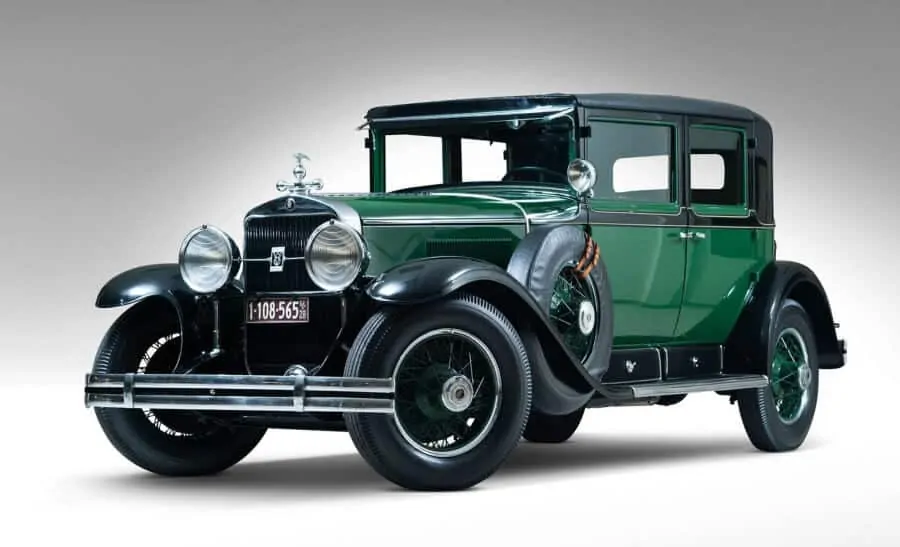
Politics Reentered
Capone began to refocus his attention on local politics, backing Republican William Hale Thompson during his mayoral campaign in Chicago. Capone shifted his charitable donations from feeding the homeless to supporting politicians. Capone took politics so seriously that on polling day in April 1928, Capone had his expert bomber, James Belcastro, blow up the voting booths where Thompson’s opponent was thought to have supporters which resulted in the death of at least 15 people. At the same time, cars full of gunmen were sent after Thompson’s major opponents and their supporters which resulted in an infamous car chase through the city culminating with the death of a Octavius Granady, an African American lawyer who challenged Thompson. Belcastro was charged with the murders in addition to four corrupt police officers who facilitated the crimes. However, before it could go to trial, all involved were released when charges were dropped as key witnesses recanted their statements and refused to testify. When the press asked if Capone was behind all of it, the police spokesmen claimed that Belcastro was an independent operator and Capone was an honest businessman.
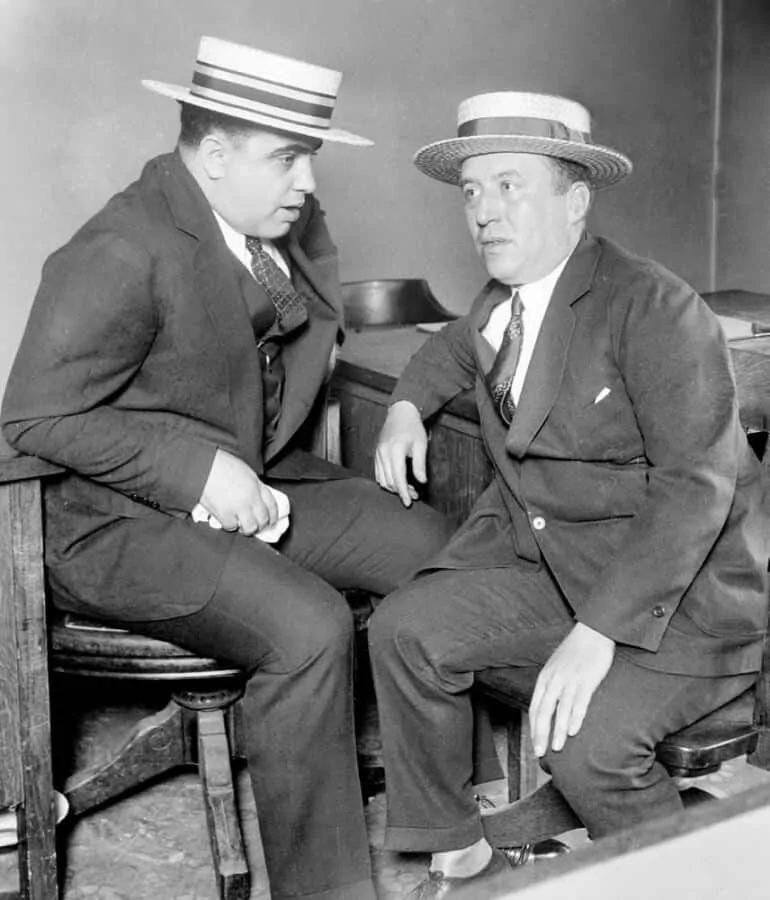
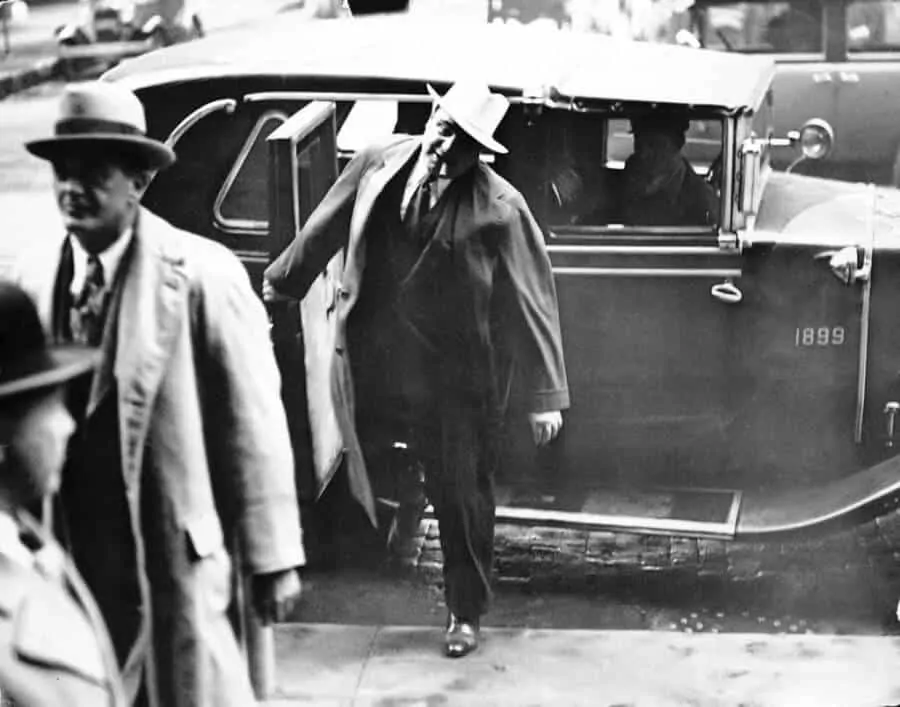
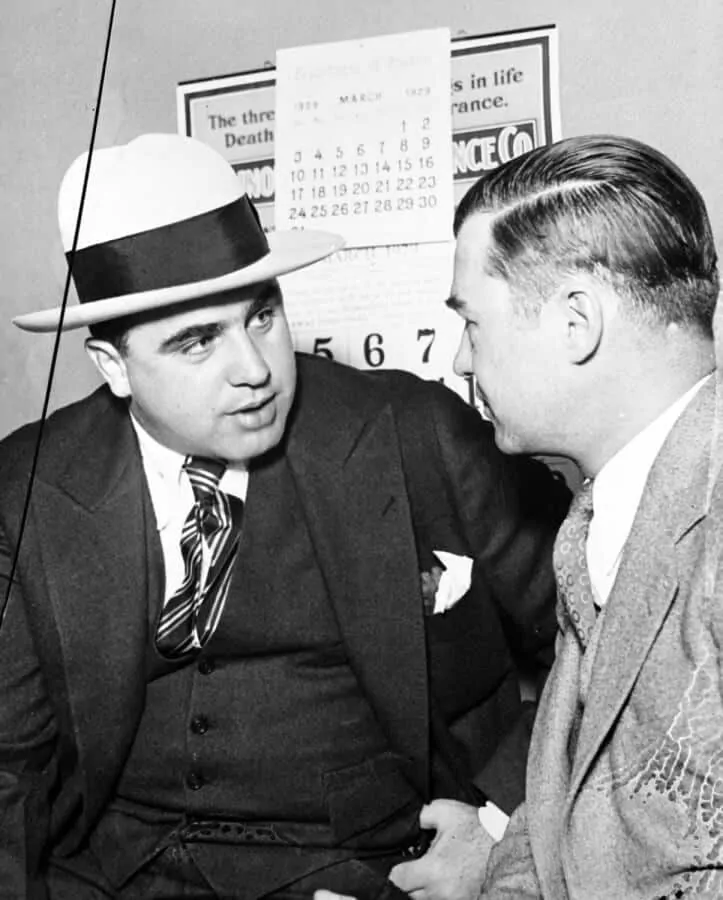
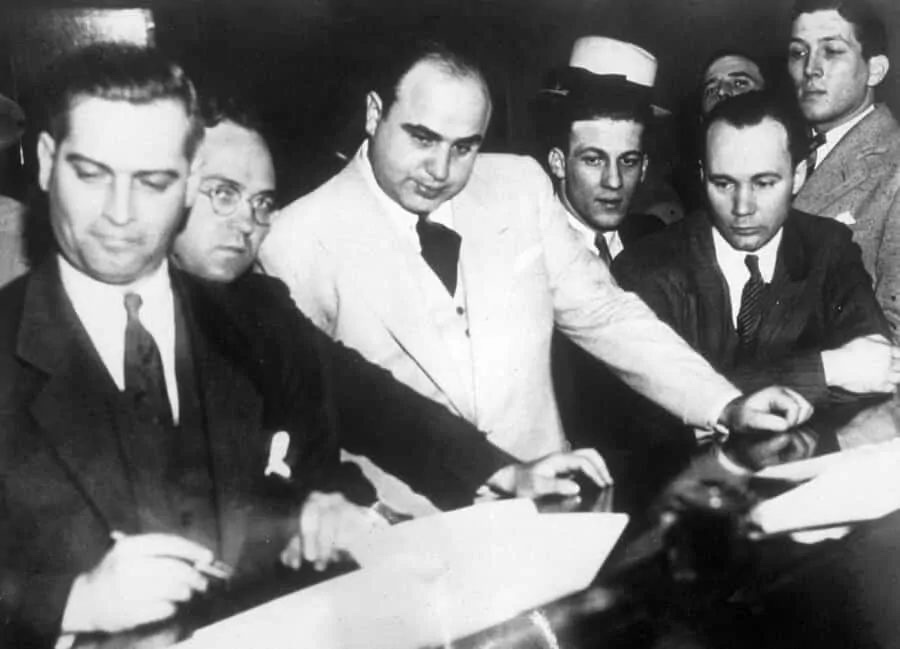
The Style of Al Capone
by Sven Raphael Schneider
Capone was a big man. During his prime he weighed about 210 pounds and stood 5’10″tall with dark hair, so he could easily intimidate people when standing over them in a bar. Probably his most well known nickname was Scarface because of the three scards on his cheek, yet he always wanted to be perceived as an elegant gentleman.
Hence he preferred the nickname Snorky which meant as much as elegant and ritzy and he deeply cared about his appearance. For example, he would always ask photographers to take a picture from the right side so his scars could not be seen.
He opted for the finest, and most expensive things he could find, after all he wanted others to know he was the man. As such, he was not man of subtlety and so he didn’t shy away from diamond belt buckles and pinky rings with huge diamonds.
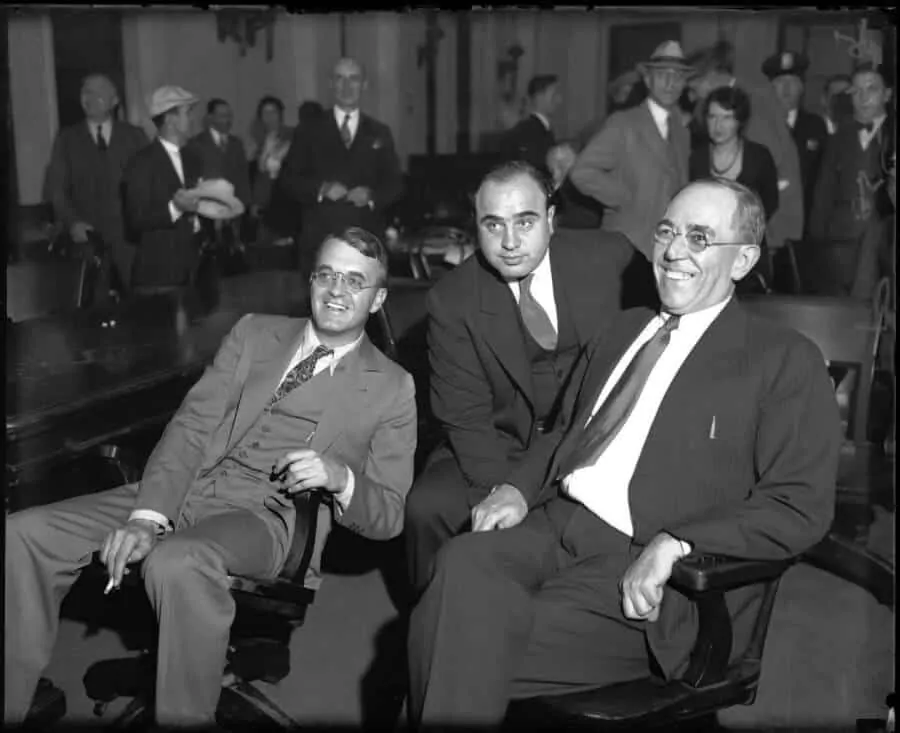
Al Capone’s Suits
When most people think of Capone, they picture him in dark three piece pin stripe or chalk stripe suits, fedora hats and a cigar in his mouth.
In fact, he did wear those suits and often had the fine silk fabrics or blends imported from Italy at $500 a suit length which would be about $6,500 in today’s money. Other colors included charcoal, navy but also tan, beige and bright colors such as purple or lime.
In a way, his fine suits were the antithesis to his rough early life. The silhouette were either double breasted in 6×2, 4×1 or 4×1. All of them had wide lapels, a vest and full cut trousers. He would also wear two button single breasted coats at times with the same full cut trousers and single breasted vests. When in Florida, he would switch to lighter summer colors such as tan and beige and have his jackets tailored with patch pockets, which made perfect sense given the warm climate.
He was also a fan of white pocket squares which were added in a rakish fold to his chest pocket.
Usually he would either wear a fedora hat in a light contrasting color or a boater hat with his dark three piece suits.
The Shirts
His shirts were white with a classic long point collar and some tie space. Interestingly, he seems to have favored buttoned barrel cuffs over cufflinks. Considering his affinity to bling and pinky rings, that’s rather surprising.
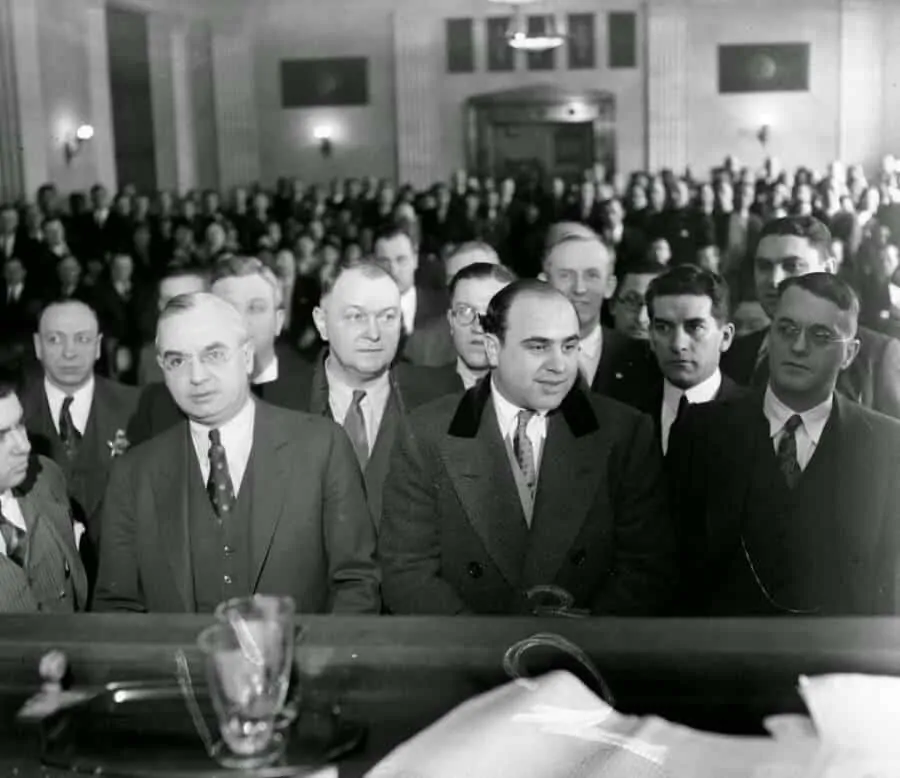
The Ties of Al Capone
Capones ties were usually made of silk and contemporary patterns, dots, micropatterns, jacquard weaves and stripes which were often dark grey, blue or red. He favored wide ties of 3.5″ / 9cm width and tied them in a four with an asymmetrical four in hand knot.
Overcoats
His overcoats were usually double breasted but sometimes also single breasted and tailored of heavy wool cloth.
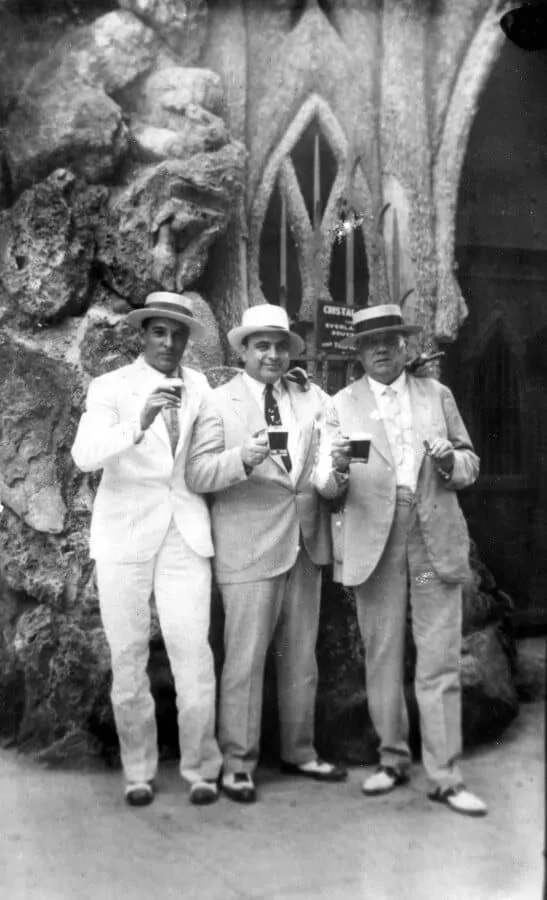
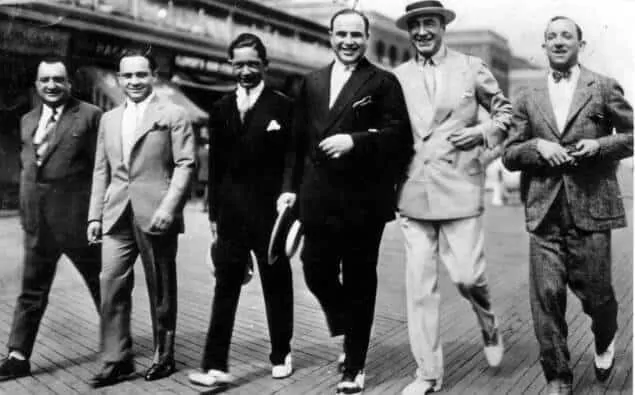

His Shoes
Capone usually wore expensive black or brown oxfords sometimes with wingtips with his darker suits. In warmer climates, he would always wear spectators but unlike popular believe nowadays that he wore black and white spectator shoes, it seems like he hardly ever wore spectators with dark suits.
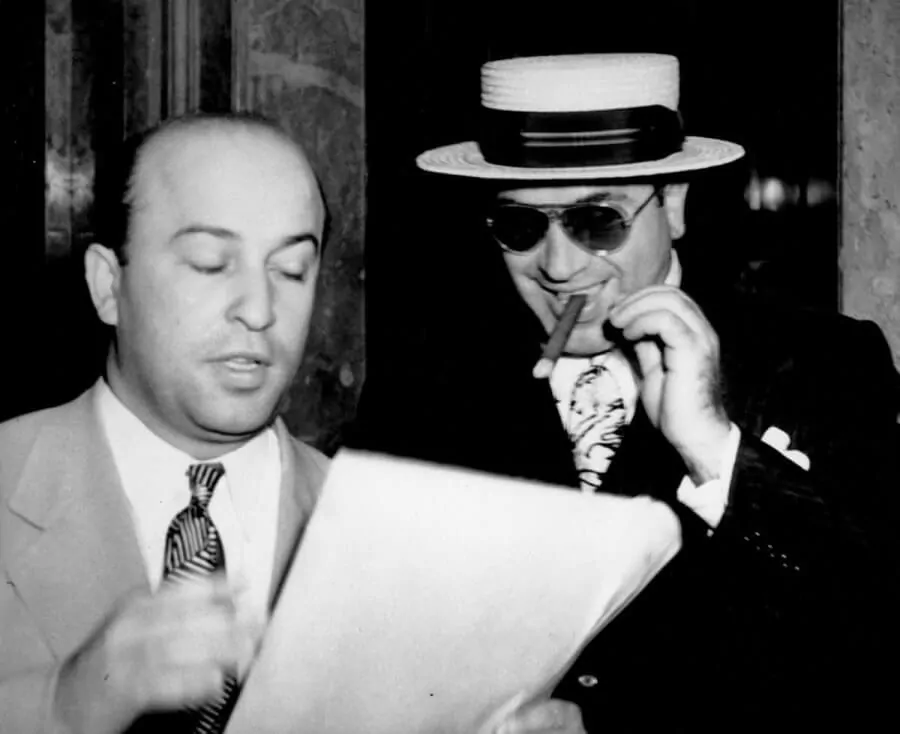
Cigar
Similar to Winston Churchill, the cigar was a big part of his persona, and it’s one of the first things that comes to mind when picturing Capone.
The End of an Era
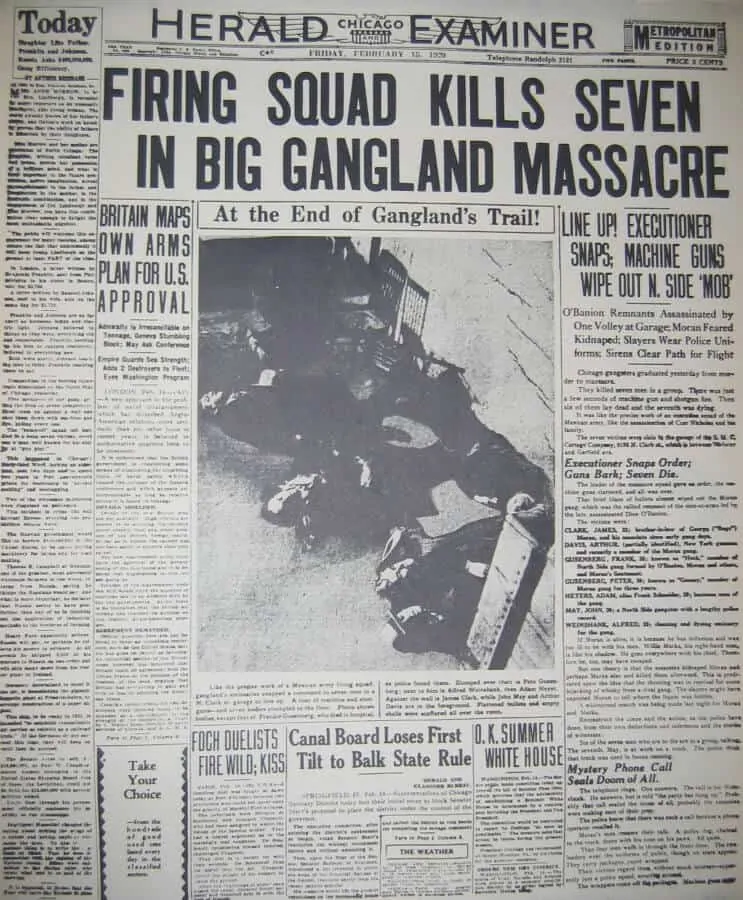
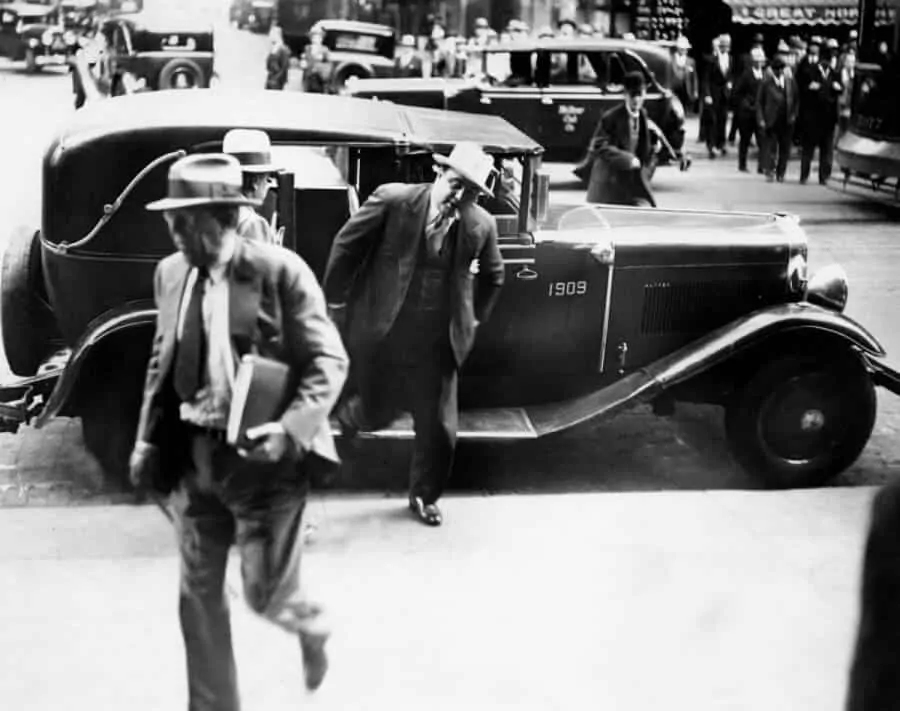
This corruption in Chicago’s politics continued until February 14th, 1929 – Valentine’s Day.
Capone, intent on ridding the city of the North Side Gang, ordered a hit on Bugs Moran, the only surviving member of the original leadership.
Capone allegedly had his men rent an apartment across the street from the trucking warehouse and garage that served as Moran’s headquarters. The apartment was used to conduct surveillance on Moran and his henchmen. On the morning of February 14th, Capone’s lookouts gave the signal and hitmen disguised as uniformed policemen “raided” Moran’s building. The police impersonators lined up the seven men in the warehouse along a wall claiming they were conducting a properly authorized raid of the premises. Moran and his men lined the wall without incident and on their own accord and as the faux policemen distracted them, gunmen armed with machine guns entered from behind and killed all seven victims.
Almost immediately photos of the dead victims leaked to the press and Capone was blamed outright for the massacre putting an end to his previously stellar public reputation. Within days Capone was summoned to testify before a grand jury on violations of federal prohibition law, but he refused, claiming he was unwell and could not leave his home.
Knowing he couldn’t run from the summons for long, he testified to a grand jury on March 27th, 1929. As he left the courtroom, he was arrested by FBI agents waiting outside the courthouse on charges of contempt of court for feigning illness to avoid his earlier appearance.
A team of federal agents known as the Untouchables and led by lawman Elliot Ness of the US Treasury Agency was tasked with taking down Capone and his syndicate. When Capone was sentenced in May of that year to serve time, Ness and his team increased their investigation of Capone as he sat behind bars. Just one week after his release from prison in March 1930, Capone was listed as Public Enemy Number One by the Chicago Crime Commission.
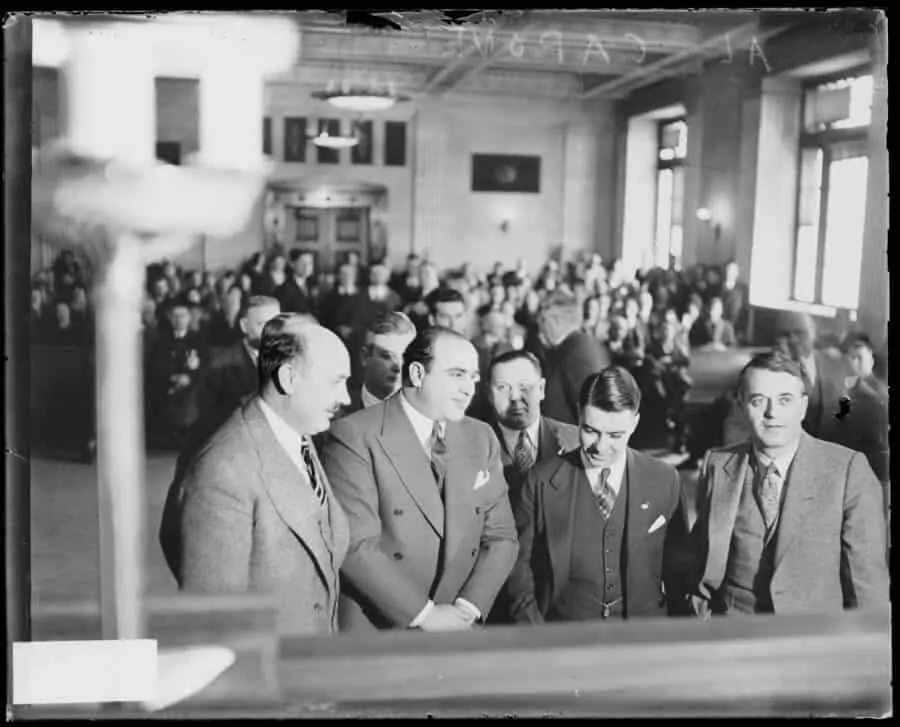
With law enforcement hot on his heels and Elliot Ness refusing to back down, Capone was arrested less than a month later on vagrancy charges when he tried to visit his retreat in Florida. The Governor, being made aware of Capone, ordered Sheriffs to run him out of town. Following suit, a Chicago judge with political desires issued a warrant for Capone and had him arrested in September on the same vagrancy charges. Using the charge and his affiliation with the current mayor Thompson, the judge used the publicity to run against Thompson in the Republican primary.
By February 1931, Capone was again convicted of contempt of court and sentenced to six months, but remained free as his attorney appealed the conviction.
Using legal loopholes that entitled Capone to forgo claiming profits from criminal activity on his tax return, a Supreme Court ruled that the income had to be declared and that the loophole used by Capone stretched the Fifth Amendment too far. The IRS assigned a task force to investigate Capone led by Frank J. Wilson. Since Capone didn’t own any assets in his name and didn’t have a bank account, Wilson instead focused his attention on Capone’s lavish spending practices. Knowing that Capone could never afford the clothing, accessories, cars, jewelry and cigars on his declared income, Wilson used the spending as a way to prove Capone had falsified his income. In addition, the IRS targeted Capone’s key employees including his brother Ralph who was convicted of tax evasion in 1930 and spent three years in prison.
Hoping to escape a prison sentence, Capone ordered his lawyer to regularize his tax position and through his lawyer, an offer was made to the government which conceded his large income for specific years with an offer to pay income tax. Despite this, Capone was charged with tax evasion in 1931 as well as various violations of the Volstead Act.
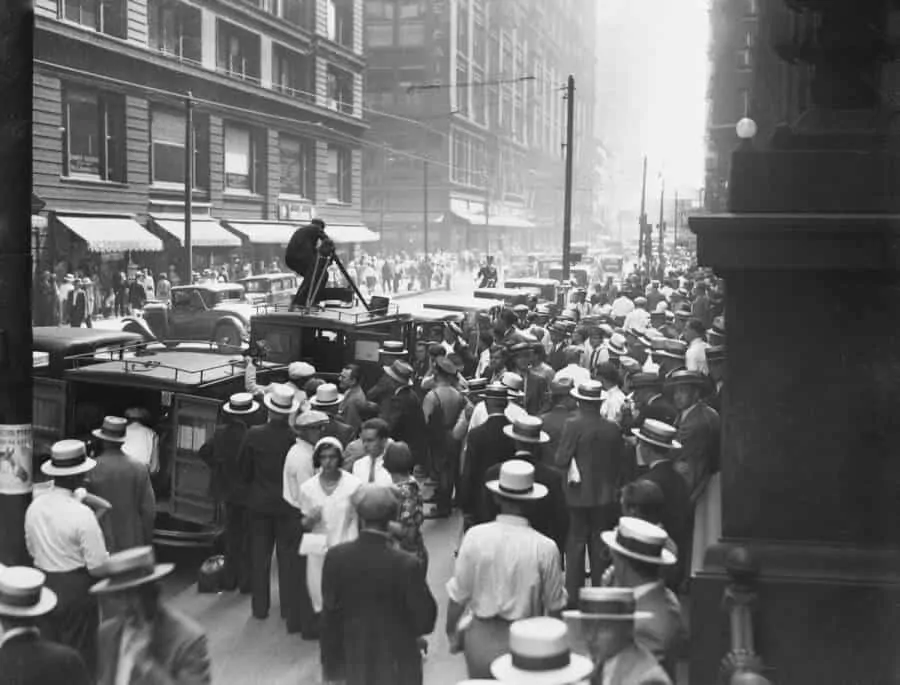
Judge James Herbert Wilkerson who also presided over Ralph Capone’s case was familiar with Capone and his antics. When US Attorney George E. Q. Johnson agreed to a plea bargain that only gave Capone a couple of years in prison, Judge Wilkerson overruled it, refusing to allow Capone to plead guilty in hopes of receiving a reduced sentence. The Judge ruled that while he wouldn’t accept the guilty plea due to Capone’s lawyer admitting the guilt instead of Capone himself, he would admit the confession into evidence on the grounds that anyone making a statement to the government did so at their own risk, including an authorized legal representative of Capone.
The case was now based on the size of Capone’s income using his spending habits as evidence of his income. In November 1931, Capone was convicted of tax evasion and sentenced to eleven years in federal prison. In addition, Judge Wilkerson fined him $50,000 plus an addition $7,692 for court costs and a further $215,000 plus interest for back taxes. The judge further ordered that Capone would serve a contempt of court sentence concurrently.
Shocked, Capone retained the services of Washington-based lawyers specializing in taxation. They filed a writ of habeas corpus based on the Supreme Court ruling that since tax evasion wasn’t fraud, Capone had been convicted on charges that were related to years that were outside the time limit for prosecution. Anticipating that the conviction would be overturned, Capone was in for a big surprise when the judge creatively interpreted the law so that the time that Capone had spent in Florida over the years could be subtracted from the age of the offenses. Based on that time frame, the appeals were overturned.
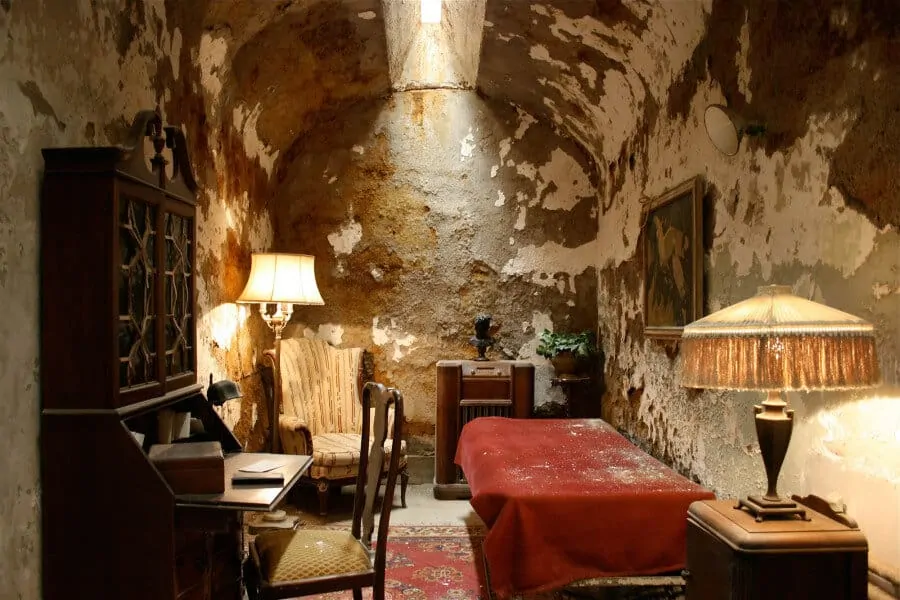
Capone in Prison
In May 1932, at the age of just 33, Capone entered the prison system reporting for sentencing at Atlanta U.S. Penitentiary. At the time of his arrival, Capone was coming down from cocaine use and was in withdrawal. Sent to the infirmary, he was also diagnosed with syphilis and gonorrhea in addition to a perforated septum due to the cocaine. At 250lbs, Capone was no longer the tough guy he once was and was viewed by his fellow inmates as being weak. Fortunately, for Capone, he was celled with a former employee of his named Red Rudinsky who took pity on Capone and became his protector in the yard.
Other prisoners began to think that Capone was receiving preferential treatment and for his own safety, Capone was transferred to the soon-to-be infamous and newly opened Alcatraz Federal Penitentiary.
As a prison in Alcatraz, Capone’s health began to rapidly decline and the neurosyphilis began to erode his mental stability. Now, in the last year of his sentence, he spent the majority of it in the prison’s infirmary confused and mentally unstable. On January 6, 1939, Capone was released from Alcatraz and transferred to the Federal Correctional Institution at Terminal Island to serve out his concurrent sentence for contempt of court. He was paroled later that year on November 16th.
Still weak and plagued with illness, Capone was feared to Johns Hopkins Hospital in Baltimore as they specialized in the treatment of paresis caused by late-stage syphilis. However, upon his arrival, hospital administration refused to treat him due to his reputation and he was barred from the premises. Union Memorial Hospital took him in and cared for him. Thankful for their compassion and help, Capone donated two Japanese weeping cherry trees to the hospital. After a few weeks of treatment, Capone, still very ill, left Baltimore in March 1940 for Palm Island, Florida.
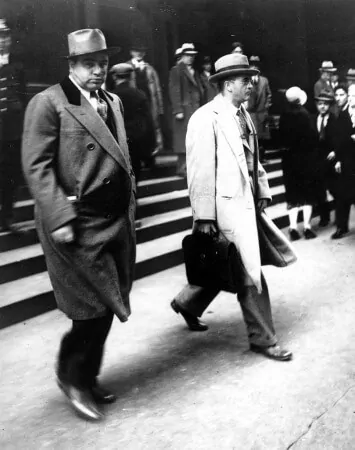
The illness had taken its toll on Capone and doctors determined in 1946 that he had the mental capacity of a 12 year old child. Capone spent the last few years of his life in solitude at his retreat in Florida. On January 21, 1947, Capone suffered a major stroke. Despite surviving it, he contracted pneumonia during recovery and went into cardiac arrest just a few days later, on January 25th, 1947. As a result of the cardiac arrest, in combination with his other ailments, Capone died at his home surrounded by family. He was buried at Mount Carmel Cemetery in Hillside, Illinois.
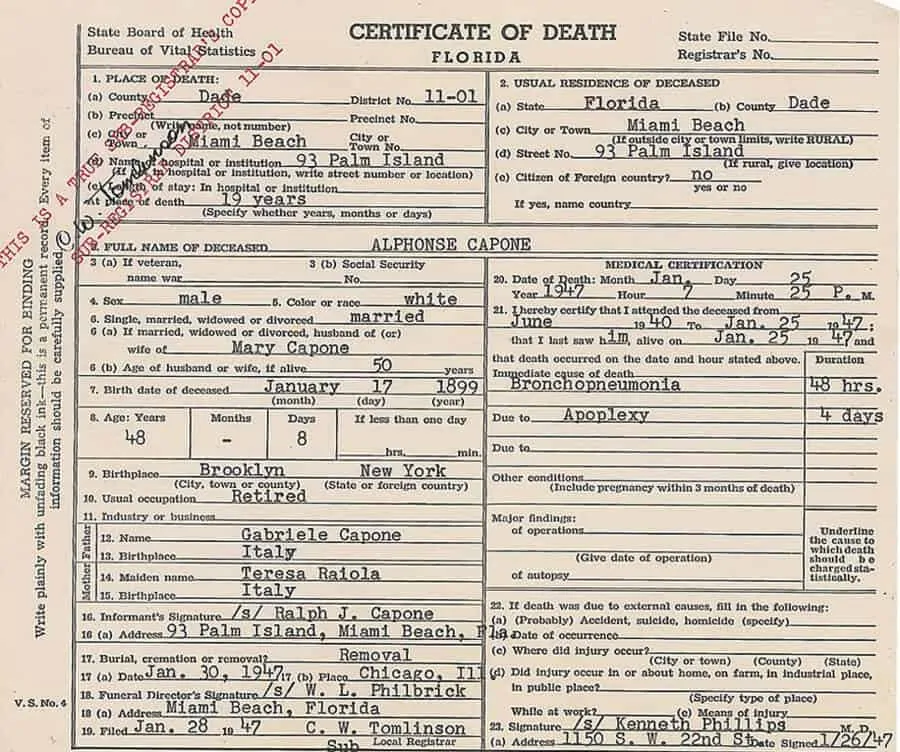
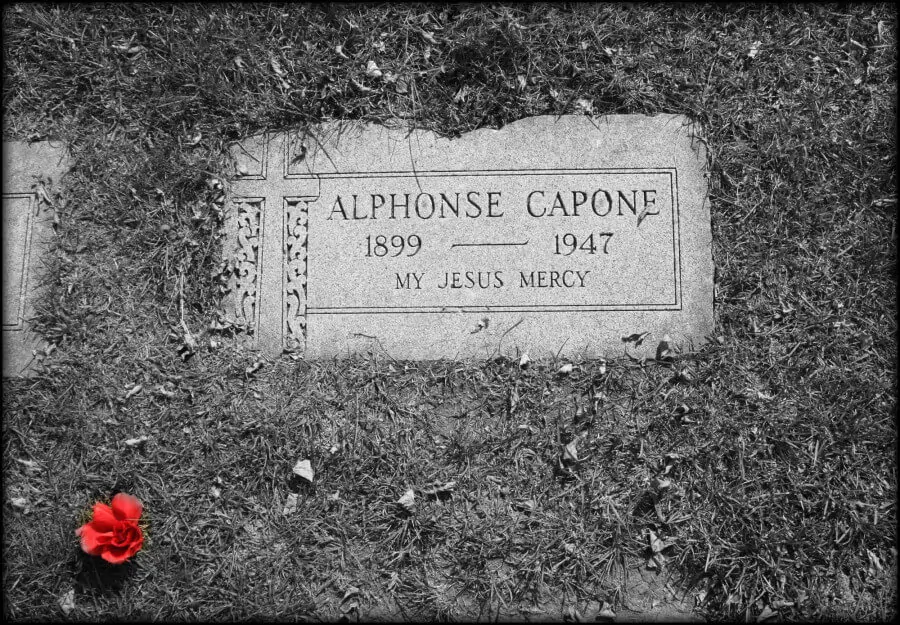
Recommended Reading
Capone; the life and world of Al Capone by John Kobler
The definitive biography on the man that the public called Scarface, the FBI called Public Enemy Number One and fellow gangsters called Snorky. Capone will forever be remembered as one of America’s most pinnacle mobsters. Click here for a copy.
Get Capone : the secret plot that captured America’s most wanted gangster by Jonathan Eig
A riveting focus on the backstory behind the walls at the FBI and Treasury Department. The true details of what it took to put America’s gangster behind bars. Click here to buy your copy.
Capone : the man and the era by Laurence Bergen
The dramatic and brilliantly told history of prohibition and how Al Capone capitalized on the need for liquor. From the seedy backroom deals to the reign of terror and fear that Capone’s gang struck into the hierarchies of Chicago’s elite, this is a fascinating chronicle of how one man on the bottom ended up on top. Click to buy your own copy.
Bootleg: Murder, Moonshine, and the Lawless Years of Prohibition by Karen Blumenthal
Not specifically about Capone, this story focuses on the entirety of the underworld and how it profited during some of America’s darkest days. A core focus of course is on the monopoly Capone obtained over the black markets of Chicago during Prohibition. Click here for a copy.
There are dozens of books written about Al Capone, but these are the ones we consider the most definitive works. What are some of your favorite books about Scarface?
Capone’s Legacy
Despite ceasing to be boss immediately on his imprisonment, many argue that it wasn’t Capone’s criminal activities that resulted in his takedown, but that it was actually his larger-than-life lifestyle. After all, Capone was never convicted of any violent crimes, but of tax evasion which was proven using his spending habits as evidence.
Since his death, Capone’s likeness has been featured in many movies and TV shows. He’s often the inspiration for gangsters portrayed in all forms of entertainment and media including comic books, video games and novels.
At the same time he is a good example that it takes more to be a gentleman than just nice clothes. No matter how nice a criminal dresses and how elegant he portrays himself, he will remain a criminal.
Nevertheless, Capone’s legacy lives on today, not due to his criminal activities but due to his style, panache and the fact that he worked himself up from nothing. He was a very violent and ruthless crime boss, but there have been many more that achieved greater success as criminals in comparison to Capone. However, despite that, there are none that lived their lives so lavishly and as publicly as Al Capone. Heroes like Elliot Ness live forever in the history books, but legends like Al Capone seemingly never die.
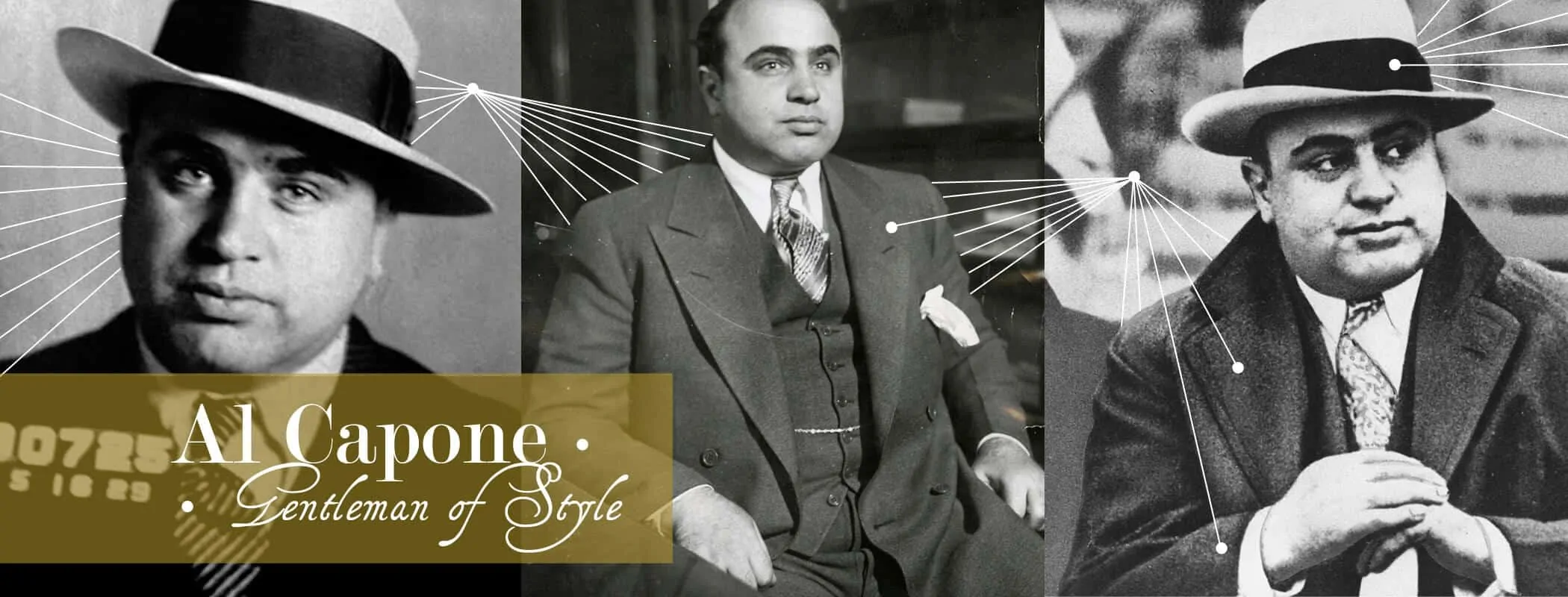
Gangster style is flash not class–with a few exceptions. I’ve been with some of the top and the mob guy is usually a fop, not a dandy. Doubt me? Check out my c.v. on my website under FAQ.
Dear Raphael ,
Cannot come to terms with this example .
In my view men of class and style wear the clothes , the clothes do not wear them .
My late godmother who looked like Lana Turner maintained there were people of ass or class .
Mr Capone is of the former .
Mark, having a particular style does not mean one has class.
One of the reasons Capone is remembered even today is his style, but what we say is: even if you have a style and people like you for it, you are still no gentleman if you are a criminal, and Capone was a criminal. Please also read the comment I left for Mark Vigna below.
Certainly there are better “men of style” from the nineteen twenties and thirties that you can feature than a punk like Al Capone. Capone was a vicious psychopath. The fact that he walked around in stylish clothing does not heighten his stature as a public figure, but enhances his reputation as a self-centered, conscienceless thug who cared more about the fit of his suit than the human lives he slaughtered in the name of “business.” You have every right to feature whom ever you like on your website, and I defend that right. However, I am going to exercise my right to be disgusted by this one. Hopefully you’ll do better in the future.
Mark,
Capone is undoubtedly an important figure in American history. Many movies and books have been written after him and about him.
If you read the entire article, you would have seen that we do not glorify him at all.
1. The Headline contains a ? indicating that we do not claim he is a Gentleman of Style
2. We make this claim”At the same time he is a good example that it takes more to be a gentleman than just nice clothes. No matter how nice a criminal dresses and how elegant he portrays himself, he will remain a criminal. ”
And that’s our stance. He may have been stylish, he may have been respected, he may have worn nice clothes but after all, he is no gentleman but a criminal.
We are working hard to educate people and to show them various characters, so readers can reflect on it.
If you put lipstick on a pig, it’s still a pig.
Raphael,
I certainly did read the entire article the first time. I do get a sense of what you claim in your response to what I wrote. However, having read the article through to the final paragraph, I came away with the impression that the article was saying that style permeates character in the long run. Following is your final paragraph, which seems to be a hedge against remembering Capone solely for his criminal activity – which is all he deserves.
“Nevertheless, Capone’s legacy lives on today, not due to his criminal activities but due to his style, panache and the fact that he worked himself up from nothing. He was a very violent and ruthless crime boss, but there have been many more that achieved greater success as criminals in comparison to Capone. However, despite that, there are none that lived their lives so lavishly and as publicly as Al Capone. Heroes like Elliot Ness live forever in the history books, but legends like Al Capone seemingly never die.”
I am sorry if I appear to be a bit ornery about this article. I do appreciate the work you do with this website, and am sure I will continue to do so into the future.
Mark
Well, he is in fact remembered for that, and having a style and being well dressed is probably the biggest reason. But that cannot change or justify his criminal acts in any way.
A well-researched story with great photos, Raphael, as usual!
Thank you David.
Glorifying Al Capone as an example to follow? He was a thug and should never be an example of anything except a tick on humanity. What is the next Gentleman’s Gazette post? Stylish pedophiles? You are better than this. Looking forward to your positive blog posts.
Where exactly are we glorifying him? It seems to me like you did not read the article. Please see the comment I left for Mark above.
Firstly, your articles have been to me a source of leisure readings and self education in the art of being a gentleman.
Secondly, I am originally from Venezuela and as a foreigner and stranded by the little facts I know of the American culture, I could not agree more with the opinion of the previous visitors’ comments to this entry. There is an old saying in my home country that states that “what you admire you tend to imitate”. Capone -being a long known criminal- is not material of any kind of admiration at all. Despite your warnings at the beginning of the article, this article summarises your opinion and you are more than entitled to it, but it might put you to sail on troublesome waters: what other character with criminal record and sense of style might follows?
Roberto,
I think you should read the entire article, not just parts of it. Again, here is what we say”At the same time he is a good example that it takes more to be a gentleman than just nice clothes. No matter how nice a criminal dresses and how elegant he portrays himself, he will remain a criminal.”
Please see the reply I left for Mark above.
We want to show people that it pays to think critically, and even though somebody had style, is famous and remembered years after his death does not make him a gentleman.
Thanks, Raphael, for your swift response and comments. Looking forward to read your next article. Best.
Couldn’t agree more with the comments above – what next General Pinochet? He was always well turned out….
There is certainly a misplaced glamour around these murdering thugs, but if this terrotory is to be exploted I’d prefer to concentrate on the style of people who portrayed them on screen – George Raft, Jame Cagney et al, (but not Al!).
Andy,
This is the point, there is a misplaced glamour but if we do not talk about it, this glamour will stay intact forever.
Our goal is to show different kinds of style of different people and get people to think about it in a critical way.
Did you read the article in full?
. Very well written I like that a lot. Pay homage
Whether or not one agrees with the premise of the article, this is one of the more poorly written works I have struggled to read in some time. There are numerous websites and software programs that can be used to scan and offer spelling and grammar corrections, Grammerly being one of the better known offerings. I suggest, in the clear absence of an effective proofreader, that Mr. Shapira and Mr. Schneider consider employing one of those resources. It will improve clarity, enjoyment by the reader, and the professional image of the website.
No snark intended.
Thanks for pointing our Grammarly, not Grammerly as you wrote. You see it’s easy to end up with typos even in just one paragraph ;).
I noticed that error after posting but I couldn’t edit it. But, point made.
You get the gist. It’s more an issue with punctuation and structure than with spelling. Grammarly is but one of many useful tools to improve our writing.
This article is a joke – a murder is NEVER a gentleman………….
That’s exactly what we say in the article… so I guess you either cannot read or you do not want to.
Sven,
Great selection and focus as always. In truth, my father and uncles lived across the alley from Ralph Capone in Cicero, IL. They sometimes broke into their barn to steal meat, apples, and sometimes liquor. Also they admired the diamond studded pool and billiard tables, along w/ fabulous cars, usually under tarps.
As dad grew older, he realized the Capones probably knew EXACTLY who’d been stealing from them and, they just let it go. This was the darkest hours of the Great Depression and these were only KIDS.
Where I think a lot of the animosity finds its core is in the over the top depictions of AC as newer producers essentially had him looking like a disco pimp by the time the 1980’s rolled around. ( Ray Sharkey, REALLY? ) Focusing entirely on what sold their movies, violence and sex. Without sugar coating, you’ve brought a more sober perspective. Thanks as always.
We here in Malaysia has nothing to do with Al Capone,but I say the bad guys always dressed better.
Nik
I liked the article, the history behind the man who has inspired countless movies and changed the face of law enforcement. I can’t help but feel sorry for anyone who miss understand what style is and its importance. America has always been in a strange love affair with outlaws as an example the bullet riddle cloths of Bonnie and Clyde sold at an auction for $75,000.00. Who would have figured Big Al Capone opened a soup kitchen and contributed to charitable organizations. The most important thing I think you provided was how style influences our environment. People can hate Al Capone but he was given the key to impunity by the Mayor, the police departments and the people. That influence and the fact that his name his well known can be attributed to the fact that he was a well dressed person. Having style is a sense of knowing who you are and being comfortable enough to live with yourself.
Thanks for the education!
A fascinating article. Really enjoyed reading this. There is a great deal here that I did not know about the man.
This was a well put together article.
Years ago, I came across a book about Al Capone in which the makes of Sulka and Oxxford Clothes came up. I can’t prove he was a customer of those brands, but given his wealth, I think it’s a safe bet he went after the best.
I do know that in court records the prosecution made mention of how much he spent on his dress shirts, which were $10.00 a piece at the time.
A very interesting article.
I noticed the photograph at the top of the article of one of Capone’s earlier motorcars. For the last few years I have had occasion to photograph his last motorcar in action – a 1940 Cadillac V-16 Limousine. A few years ago, the Cadillac became part of the Collings Foundation in Stow, Massachusetts. Each June, on Father’s Day weekend, it’s appearance is the culmination of the American Elegance event – a parade of elegant cars from the 1920s and 1930s at the Collings Foundation, from their American-built collection, usually as Capone and his cronies are being chased by a Massachusetts State Police car, a 1941 Ford Cruiser (from the collection of the Massachusetts State Police Museum and Learning Center, Grafton, MA).
The Cadillac is currently unrestored from his appearance when it was added to the Collings collection.
He might not be the best role model, but from a grooming and style point of view, many men nowadays can learn a lot from him.
Hello all
I believe this is another very interesting piece by Sven & his team. Al Capone is an important figure despite is infamous mob career. He was a creative guy and his life created many positive consequences in the US; many movies related to his life, his cell is still a tourist attraction, he is also one of the reasons why US has better taxing system than the rest of the world.
He sure was a bad seed and will burn in hell. However, telling Sven that he was not a man to mention or giving cheap moral lessons to readers here is more offence to me than writing about him.
Without bad there is no good. History will remember good and bad. Trying to make people forget about bad guys will not change the history.
BR
Leo
Capone enjoyed life and also a pretender